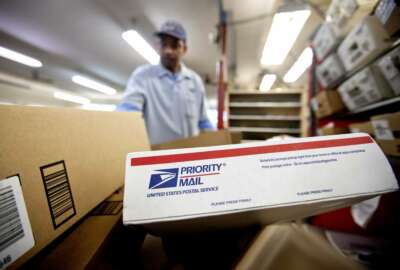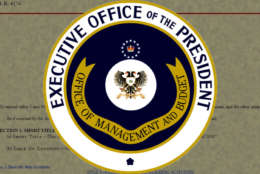
USPS 5-year business plan: ‘Innovate faster,’ cut costs to remain solvent
In an effort to course-correct from more than a decade of net financial losses, the Postal Service on Wednesday released its long-awaited five year-business plan.
Best listening experience is on Chrome, Firefox or Safari. Subscribe to Federal Drive’s daily audio interviews on Apple Podcasts or PodcastOne.
In an effort to course-correct from more than a decade of net financial losses, the Postal Service on Wednesday released a long-awaited five-year strategic plan.
Postmaster General Megan Brennan and Robert Duncan, chairman of the USPS Board of Governors, said the Postal Service faces a unique challenge operating both as a large business and as a federal agency with a mandate to provide the same level of delivery service to every address in the United States.
“Our mission and our role in America’s economy and society remain indispensable — but we can only continue to compete effectively and meet the high expectations of the public with an improved business model,” Brennan and Duncan wrote in a letter accompanying the five-year plan.
The most impactful recommendations in the strategy would require legislation from Congress, regulatory relief from the Postal Regulatory Commission and new labor agreements from the postal unions.
“Ultimately, Congress determines the contours of the Postal Service’s statutory business model and therefore has the unique authority to enable this vision or direct the Postal Service toward a different vision,” the plan states.
The plan focuses on five major goals:
- Goal 1 — Deliver world-class services and customer experiences
- Goal 2 — Equip, connect, engage, and empower employees to serve our customers
- Goal 3 — Innovate faster to deliver value
- Goal 4 — Invest in future platforms
- Goal 5 — Pursue legislative and regulatory changes necessary to achieve financial sustainability
The sweeping document comes nearly eight months after Postmaster General Megan Brennan told members of the House Oversight and Reform Committee that she and the USPS Board of Governors would release a 10-year business plan to address a $125 billion shortfall the agency expects to face over that period.
But that 10-year business plan remains pending. A USPS spokesman told Federal News Network that the agency is still working on providing a final draft of that document to Congress.
Rep. Gerry Connolly (D-Va.), chairman of the subcommittee on government operations, told Federal News Network in August that Brennan had submitted a draft version of the 10-year business plan to the committee last summer.
The five-year strategy, released by the agency’s Office of Strategic Planning, meets a statutory requirement to provide the president and Congress with a new strategic plan at least every three years.
At a meeting of the USPS Board of Governors in November, governor John McLeod Barger said the board’s Strategy and Innovation Committee had made recommendations on a draft of the Postal Service’s five-year strategic plan and received an in-depth briefing on the agency’s package strategy.
Kevin Kosar, vice president of research partnerships at the R Street Institute, told Federal News Network that the plan revisits some ideas like adding digital features into USPS mail products, but also focuses on a new concept of the Postal Service trying to “pivot its parcel system to focus more heavily on the wants and needs of consumers and small shippers, as opposed to big retailers.”
Related Stories

USPS begins search for new postmaster general amid 13 years of net losses

USPS board finally reaches quorum as 10-year postal reform plan comes into focus
The five-year plan, however, makes no mention of a White House postal task force’s December 2018 recommendations, which proposed rolling back unions’ collective bargaining rights for compensation.
Paul Steidler, a senior fellow of logistics issues at the Lexington Institute, said that given the task force’s recommendations, “it would be a helpful catalyst for postal reform legislation to see what common ground can be found between USPS and Treasury on important issues. This will also help the Postal Service avoid insolvency and to thrive.”
Current limits on USPS’s business model include a price cap on mail products linked to the Consumer Price Index, a mandate to deliver to every address six days a week and a mandate to pre-fund the health benefits of future postal retirees.
Amid all of this, the Postal Service receives no annual appropriations from Congress.
“Resolving these conflicting mandates requires a national public policy discourse that hinges on a basic question for the American public: What would you like the Postal Service to become and how would you like to pay for it?” the plan states.
The strategy looks at ways to develop a postal workforce of the future that includes updated training and career paths, and looks for ways to “refine and adapt” its Pay-for-Performance (PFP) system for managers and supervisors.
“To better understand the changing training needs and demographics of our workforce, we will develop predictive models and data-driven approaches for assessing our talent pipeline,” the plan states. “We will evolve our Human Resources (HR) services platform to be a single stop for all HR needs for employees while continuing to modernize and improve HR processes and technologies to drive employee access and platform adoption.”
‘Flexible and frictionless’ package service
To overhaul its customer experience, the USPS plan looks beyond the agency’s 26,000 brick-and-mortar post offices, and looks at providing digital services “that enhance the value of our physical delivery services.”
That includes “flexible and frictionless” package returns from every home and expanding seven-day-a-week parcel delivery service to ensure retailers like Amazon can continue to guarantee two-day delivery.
In an effort to generate mail and additional packages, USPS has proposed expanding self-service package returns to allow customers to print labels even when they aren’t provided with shipments.
“Consumers can visit a local Post Office and scan the QR code on a phone to receive a label or even notify the office that a return package is ready for pickup. These innovations remove the customer friction point of bringing the package to a store or shipper to return it,” the plan states.
That plan also includes expanding Informed Delivery, a free service that emails customers a scan of their incoming mail each day, to a broader base of users. Other proposed enhancements include operability on all major smart devices and connectivity with social media and e-commerce platforms.
‘Right-sizing’ amid declining mail volume
Beyond introducing new and expanded services, the strategy also looks at “right-sizing” and increasing the efficiency of the agency’s vast mail processing and transportation infrastructure through its Optimize Network Platform Initiative.
“Although our projections suggest continued decreases in the demand for mail delivery services, there will still be significant demand and the expectation that all residents of the United States will retain the ability to send and receive mail delivery services from their homes and businesses,” the plan states.
More Agency Oversight News
Meanwhile, USPS revenue has declined almost 5% over the last 13 years, with a growing percentage of the revenue coming from packages. However, with package growth volume slowing, postal officials have repeatedly warned the USPS can’t rely on package delivery to remain solvent.
Meanwhile, USPS has seen revenue from first-class mail — its most profitable product — decrease by 34 percent since 2007.
If Congress fails to deliver postal reform legislation, USPS remains dire in its warnings: The agency would run out of cash by 2021 if it paid all of its financial obligations, or by 2024 if it continued to default on payments to pre-fund benefits.
“With an eye to external factors beyond our control in current and future business environments, we are wholly focused on the expectations and experiences of our current and future customers, the American people,” the plan states.
Copyright © 2025 Federal News Network. All rights reserved. This website is not intended for users located within the European Economic Area.
Jory Heckman is a reporter at Federal News Network covering U.S. Postal Service, IRS, big data and technology issues.
Follow @jheckmanWFED






